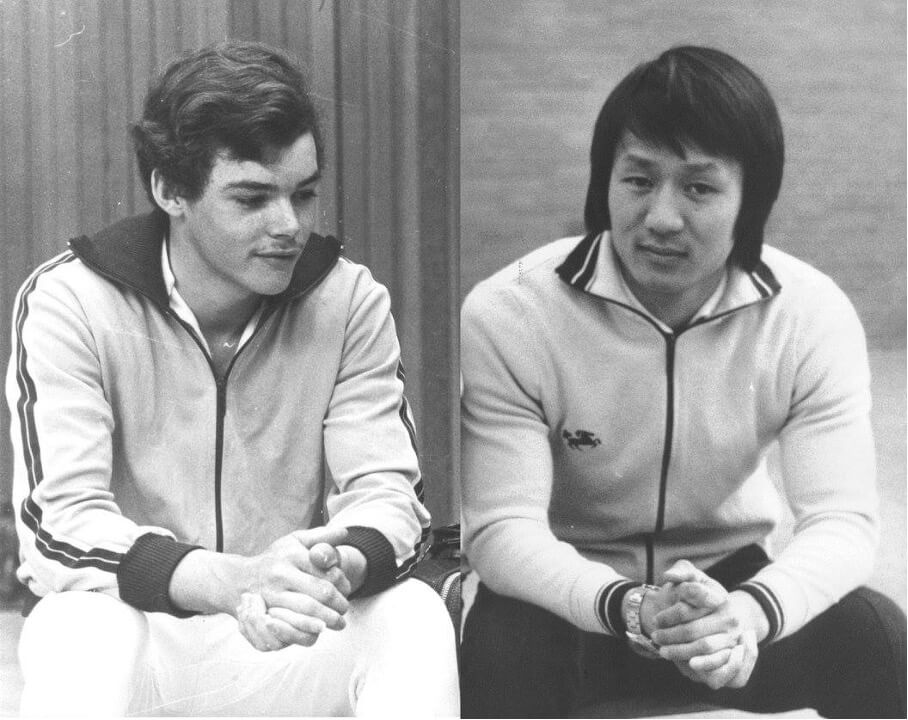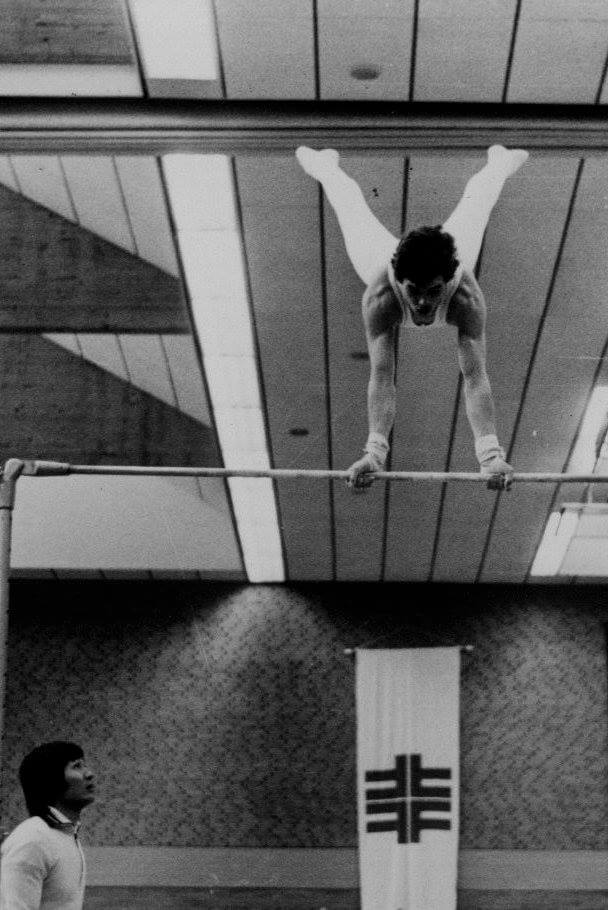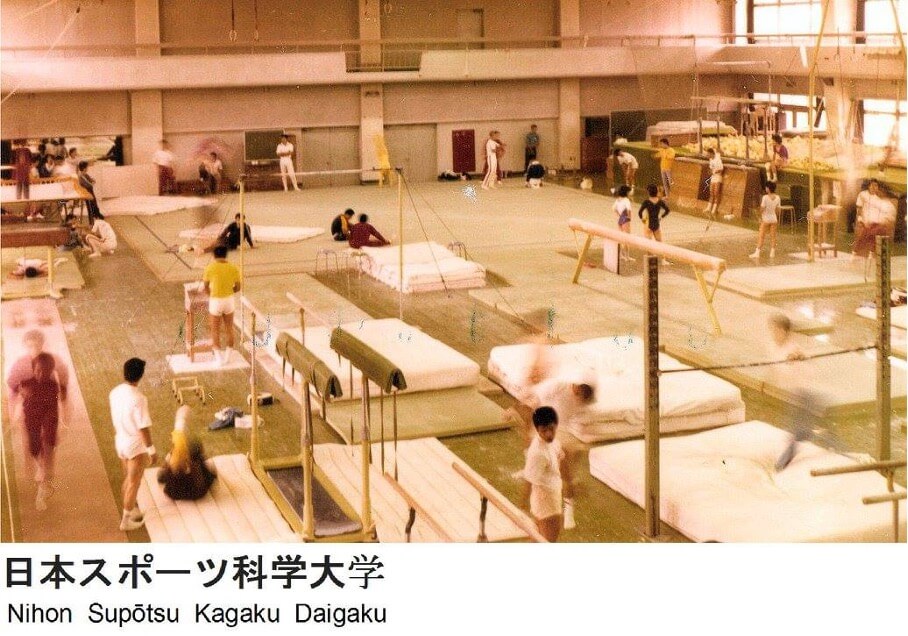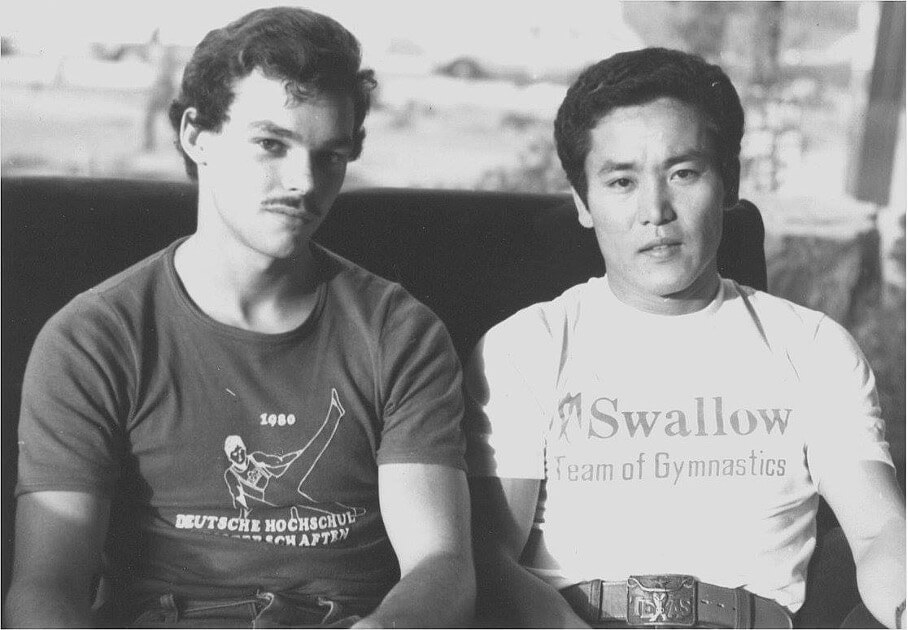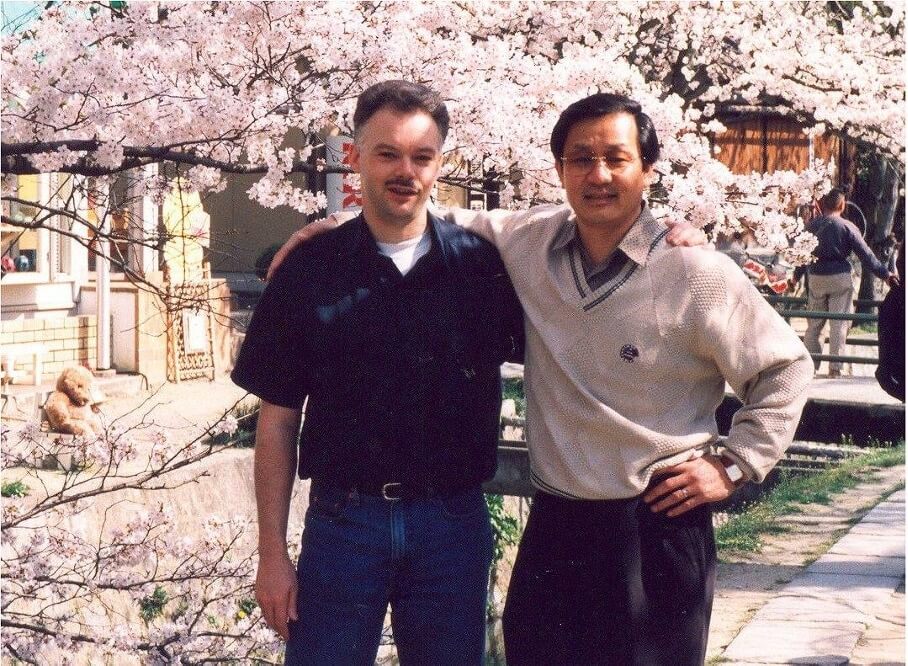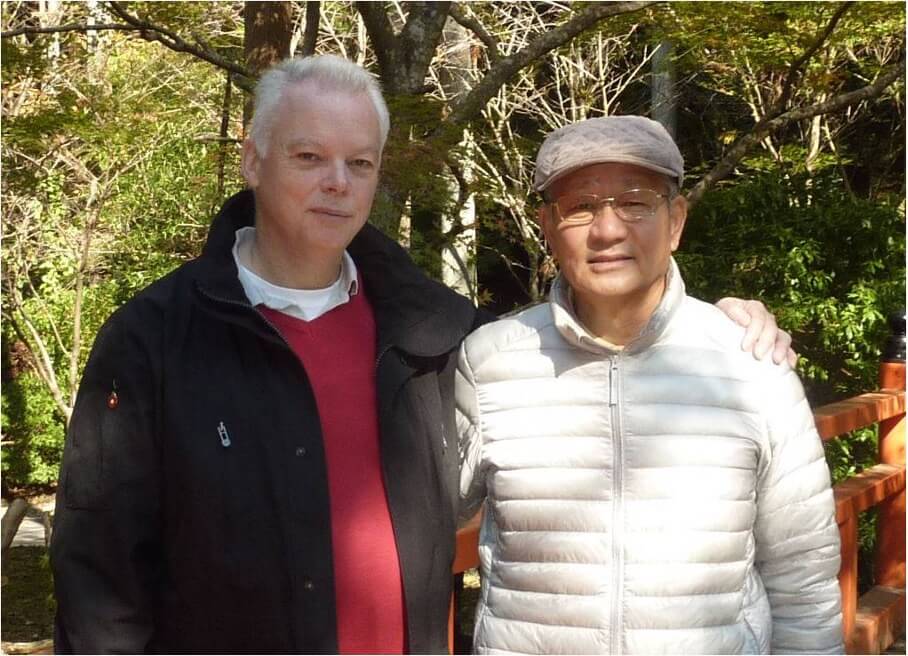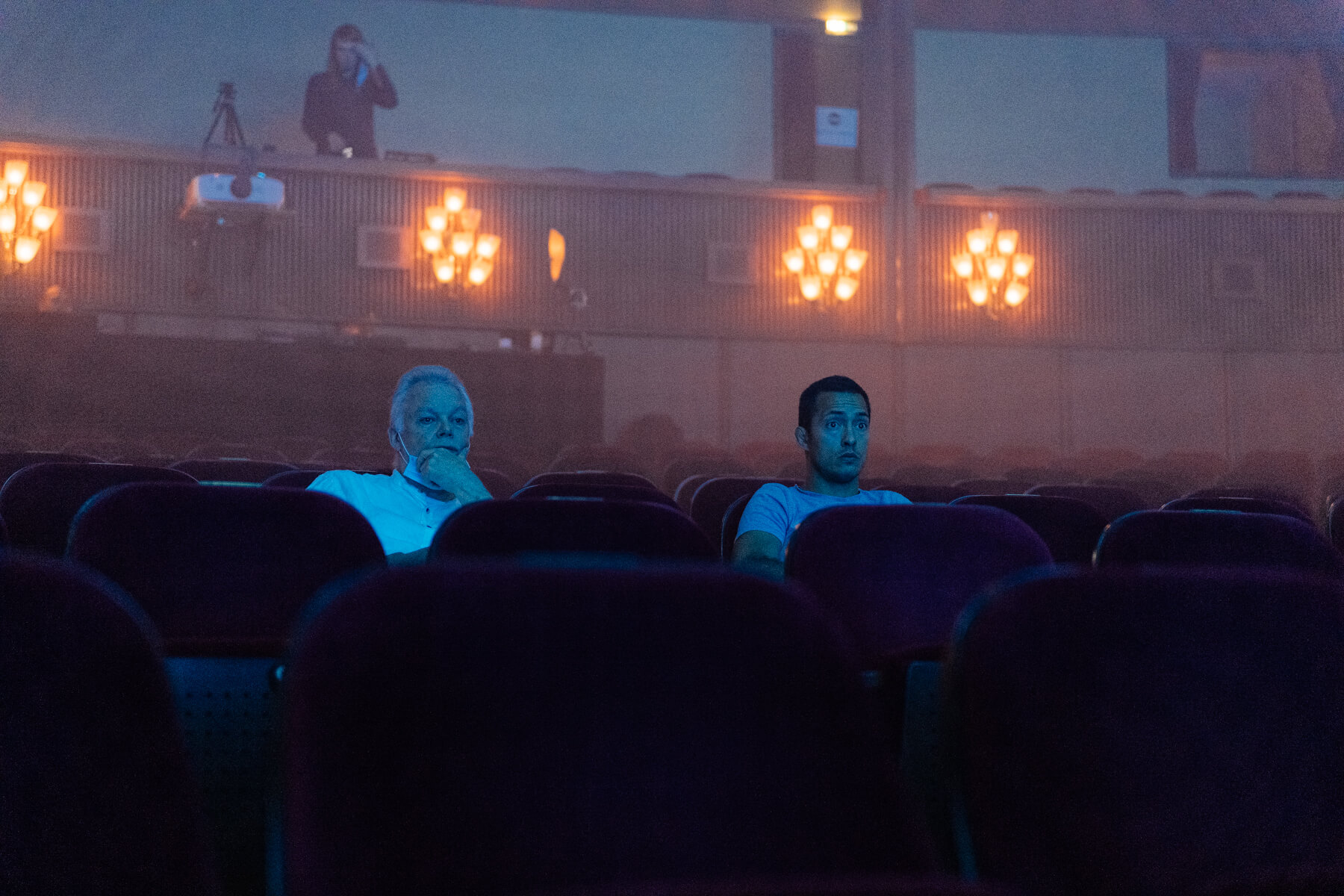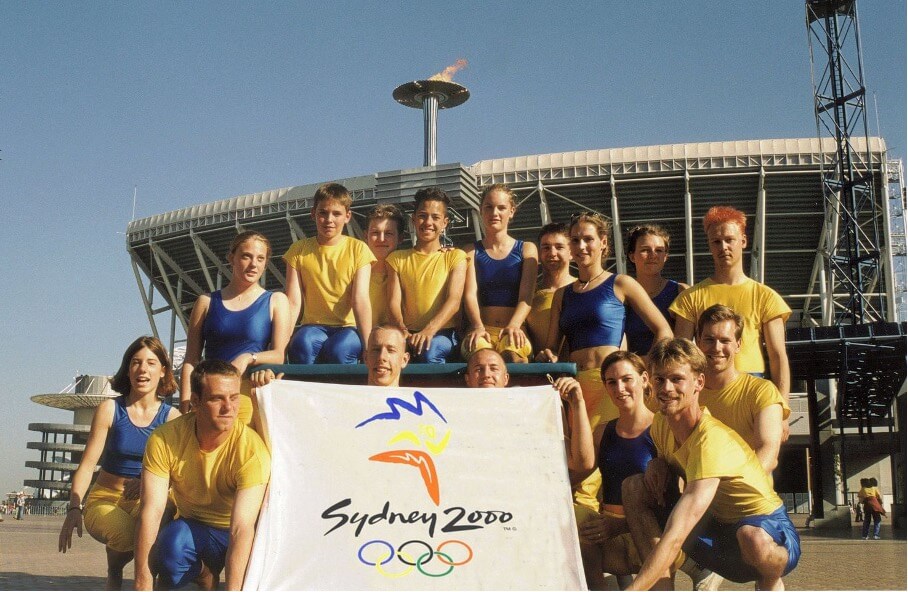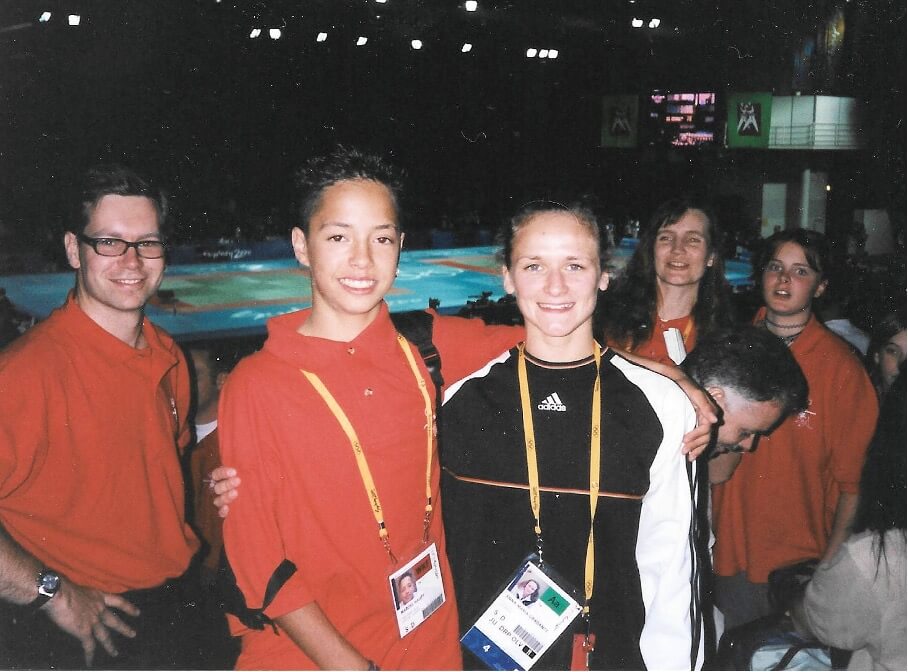

DER KREIS SCHLIESST SICH / THE CIRCLE
(1964 – 1972 – 2000 – 2021)
DER KREIS SCHLIESST SICH / THE CIRCLE (1964 – 1972 – 2000 – 2021)
DER KREIS SCHLIESST SICH / THE CIRCLE
(1964 – 1972 – 2000 – 2021)
DER KREIS SCHLIESST SICH / THE CIRCLE
(1964 – 1972 – 2000 – 2021)
DER KREIS SCHLIESST SICH / THE CIRCLE (1964 – 1972 – 2000 – 2021)
Die blaue Trainingsjacke.
Ein Text von Jochen Peitz
"Ich habe im Alter von 6 Jahren mit dem Kunstturnen begonnen. Daraus wurde eine Leidenschaft, welche ich als junger Leistungssportler enthusiastisch gelebt habe. Es gab scheinbar nichts Wichtigeres. Immer habe ich damit einhergehend die Begeisterung für den olympischen Sport geteilt. Der Klang der Fanfaren, welche zu Ehren der Olympiasieger 1964 in Tokio in den Radio- und Fernsehsendungen übertragen wurde, war mein erster bewusster olympischer Moment – ich war 7 Jahre alt. Ich kannte die damals besten Turner alle und einige Fotos von meinen Vorbildern hingen bei mir an der Wand.
Es waren in den 1970er Jahren insbesondere die japanischen Turner, welche die Bestenlisten bei Weltmeisterschaften und olympischen Spielen anführten. Da war es dann eine Fügung, dass meine Trainer im Landeskader und im Trainingszentrum aus Japan kamen. Seiji Nagase wurde dann mein Heimtrainer und später ein Freund fürs Leben. Für Deutschland war es ein großes Glück, dass die Olympischen Sommerspiele 1972 in München stattfanden. Seiji Nagase hatte in der Funktion des Betreuers und Dolmetschers einen engen Kontakt zum japanischen Turnteam, welches die Goldmedaille im Mannschaftswettkampf gewann. Er brachte eine Trainingsjacke mit, die er als Dank der Japaner vom Teamchef Yukio Endo (Olympiasieger 1960, 1964, 1968) überreicht bekam.
Es war eine blaue Jacke mit der Aufschrift „Nippon“ (Nihon = Japan). Ich habe lange im Turnzentrum an der DSHS in Köln trainiert und war ein sehr fleißiger Schüler. Ende der 1970er Jahre ging mein sehr verehrter Trainer Seiji Nagase zurück nach Japan. Mein Fleiß wurde mit einem besonderen Abschiedsgeschenk belohnt, ich bekam die blaue Trainingsjacke.
Später gab es dann eine Einladung nach Tokio. An der Nittaidai durfte ich in der Gruppe von Trainer Eizo Kenmotsu turnen. Ich habe meine sportlichen Vorbilder – die Olympiasieger von München 1972 – nahezu alle persönlich kennengelernt. Eine gute Gelegenheit ergab sich bei den japanischen Hochschulmeisterschaften 1980 in Sapporo. Ich bin meinen japanischen Freunden sehr verbunden und durfte viele Male Gast in Japan sein und Japaner in Deutschland als Gäste empfangen. Zu Seiji Nagase, der heute am Biwasee in Otzu lebt, habe ich bis heute Kontakt.
Die blaue Trainingsjacke eines Olympioniken ist das Symbol für eine wunderbare Idee, die ich gerne weiterreiche.
Der Kreis schließt sich:
1964 – 1972 – 2000 – 2021."
Die blaue Trainingsjacke.
Ein Text von Jochen Peitz
"Ich habe im Alter von 6 Jahren mit dem Kunstturnen begonnen. Daraus wurde eine Leidenschaft, welche ich als junger Leistungssportler enthusiastisch gelebt habe. Es gab scheinbar nichts Wichtigeres. Immer habe ich damit einhergehend die Begeisterung für den olympischen Sport geteilt. Der Klang der Fanfaren, welche zu Ehren der Olympiasieger 1964 in Tokio in den Radio- und Fernsehsendungen übertragen wurde, war mein erster bewusster olympischer Moment – ich war 7 Jahre alt. Ich kannte die damals besten Turner alle und einige Fotos von meinen Vorbildern hingen bei mir an der Wand.
Es waren in den 1970er Jahren insbesondere die japanischen Turner, welche die Bestenlisten bei Weltmeisterschaften und olympischen Spielen anführten. Da war es dann eine Fügung, dass meine Trainer im Landeskader und im Trainingszentrum aus Japan kamen. Seiji Nagase wurde dann mein Heimtrainer und später ein Freund fürs Leben. Für Deutschland war es ein großes Glück, dass die Olympischen Sommerspiele 1972 in München stattfanden. Seiji Nagase hatte in der Funktion des Betreuers und Dolmetschers einen engen Kontakt zum japanischen Turnteam, welches die Goldmedaille im Mannschaftswettkampf gewann. Er brachte eine Trainingsjacke mit, die er als Dank der Japaner vom Teamchef Yukio Endo (Olympiasieger 1960, 1964, 1968) überreicht bekam.
Es war eine blaue Jacke mit der Aufschrift „Nippon“ (Nihon = Japan). Ich habe lange im Turnzentrum an der DSHS in Köln trainiert und war ein sehr fleißiger Schüler. Ende der 1970er Jahre ging mein sehr verehrter Trainer Seiji Nagase zurück nach Japan. Mein Fleiß wurde mit einem besonderen Abschiedsgeschenk belohnt, ich bekam die blaue Trainingsjacke.
Später gab es dann eine Einladung nach Tokio. An der Nittaidai durfte ich in der Gruppe von Trainer Eizo Kenmotsu turnen. Ich habe meine sportlichen Vorbilder – die Olympiasieger von München 1972 – nahezu alle persönlich kennengelernt. Eine gute Gelegenheit ergab sich bei den japanischen Hochschulmeisterschaften 1980 in Sapporo. Ich bin meinen japanischen Freunden sehr verbunden und durfte viele Male Gast in Japan sein und Japaner in Deutschland als Gäste empfangen. Zu Seiji Nagase, der heute am Biwasee in Otzu lebt, habe ich bis heute Kontakt.
Die blaue Trainingsjacke eines Olympioniken ist das Symbol für eine wunderbare Idee, die ich gerne weiterreiche.
Der Kreis schließt sich: 1964 – 1972 –
2000 – 2021."
Die blaue Trainingsjacke. Ein Text von Jochen Peitz
"Ich habe im Alter von 6 Jahren mit dem Kunstturnen begonnen. Daraus wurde eine Leidenschaft, welche ich als junger Leistungssportler enthusiastisch gelebt habe. Es gab scheinbar nichts Wichtigeres. Immer habe ich damit einhergehend die Begeisterung für den olympischen Sport geteilt. Der Klang der Fanfaren, welche zu Ehren der Olympiasieger 1964 in Tokio in den Radio- und Fernsehsendungen übertragen wurde, war mein erster bewusster olympischer Moment – ich war 7 Jahre alt. Ich kannte die damals besten Turner alle und einige Fotos von meinen Vorbildern hingen bei mir an der Wand.
Es waren in den 1970er Jahren insbesondere die japanischen Turner, welche die Bestenlisten bei Weltmeisterschaften und olympischen Spielen anführten. Da war es dann eine Fügung, dass meine Trainer im Landeskader und im Trainingszentrum aus Japan kamen. Seiji Nagase wurde dann mein Heimtrainer und später ein Freund fürs Leben. Für Deutschland war es ein großes Glück, dass die Olympischen Sommerspiele 1972 in München stattfanden. Seiji Nagase hatte in der Funktion des Betreuers und Dolmetschers einen engen Kontakt zum japanischen Turnteam, welches die Goldmedaille im Mannschaftswettkampf gewann. Er brachte eine Trainingsjacke mit, die er als Dank der Japaner vom Teamchef Yukio Endo (Olympiasieger 1960, 1964, 1968) überreicht bekam.
Es war eine blaue Jacke mit der Aufschrift „Nippon“ (Nihon = Japan). Ich habe lange im Turnzentrum an der DSHS in Köln trainiert und war ein sehr fleißiger Schüler. Ende der 1970er Jahre ging mein sehr verehrter Trainer Seiji Nagase zurück nach Japan. Mein Fleiß wurde mit einem besonderen Abschiedsgeschenk belohnt, ich bekam die blaue Trainingsjacke.
Später gab es dann eine Einladung nach Tokio. An der Nittaidai durfte ich in der Gruppe von Trainer Eizo Kenmotsu turnen. Ich habe meine sportlichen Vorbilder – die Olympiasieger von München 1972 – nahezu alle persönlich kennengelernt. Eine gute Gelegenheit ergab sich bei den japanischen Hochschulmeisterschaften 1980 in Sapporo. Ich bin meinen japanischen Freunden sehr verbunden und durfte viele Male Gast in Japan sein und Japaner in Deutschland als Gäste empfangen. Zu Seiji Nagase, der heute am Biwasee in Otzu lebt, habe ich bis heute Kontakt.
Die blaue Trainingsjacke eines Olympioniken ist das Symbol für eine wunderbare Idee, die ich gerne weiterreiche.
Der Kreis schließt sich:
1964 – 1972 –
2000 – 2021."
The blue jacket.
A Text by Jochen Peitz
"I started artistic gymnastics at the age of 6. This became a passion, which I enthusiastically lived as a young competitive athlete. There seemed to be nothing more important. I have always shared the enthusiasm for Olympic sport. The sound of the fanfares, which were broadcast on radio and television in honour of the Olympic champions in Tokyo in 1964, was my first conscious Olympic moment - I was 7 years old. I knew all the best gymnasts at that time and some photos of my idols were hanging on my wall.
In the 1970s, it was the Japanese gymnasts in particular who topped the rankings at the World Championships and the Olympic Games. It was a coincidence that my coaches in the national squad and in the training centre came from Japan. Seiji Nagase became my home coach and later a friend for life. Germany was very fortunate that the 1972 Summer Olympics were held in Munich. Seiji Nagase had close contact with the Japanese gymnastics team, which won the gold medal in the team competition, in the function of coach and interpreter. He brought a training jacket with him, which was presented to him by team manager Yukio Endo (Olympic champion 1960, 1964, 1968) as a thank-you from the Japanese.
It was a blue jacket with the inscription "Nippon" (Nihon = Japan). I trained for a long time at the gymnastics centre at the DSHS in Cologne and was a very diligent student. At the end of the 1970s, my very revered coach Seiji Nagase went back to Japan. My diligence was rewarded with a special farewell gift, I was given the blue training jacket.
Later, there was an invitation to Tokyo. At the Nittaidai, I was allowed to do gymnastics in coach Eizo Kenmotsu's group. I met almost all my sporting idols - the 1972 Munich Olympic champions - in person. A good opportunity came at the 1980 Japanese University Championships in Sapporo. I am very close to my Japanese friends and was allowed to be a guest in Japan many times and to receive Japanese in Germany as guests. I am still in contact with Seiji Nagase, who now lives at Lake Biwa in Otzu.
The blue training jacket of an Olympic athlete is the symbol of a wonderful idea that I am happy to pass on.
The circle closes:
1964 – 1972 – 2000 – 2021."
The blue jacket.
A Text by Jochen Peitz
"I started artistic gymnastics at the age of 6. This became a passion, which I enthusiastically lived as a young competitive athlete. There seemed to be nothing more important. I have always shared the enthusiasm for Olympic sport. The sound of the fanfares, which were broadcast on radio and television in honour of the Olympic champions in Tokyo in 1964, was my first conscious Olympic moment - I was 7 years old. I knew all the best gymnasts at that time and some photos of my idols were hanging on my wall.
In the 1970s, it was the Japanese gymnasts in particular who topped the rankings at the World Championships and the Olympic Games. It was a coincidence that my coaches in the national squad and in the training centre came from Japan. Seiji Nagase became my home coach and later a friend for life. Germany was very fortunate that the 1972 Summer Olympics were held in Munich. Seiji Nagase had close contact with the Japanese gymnastics team, which won the gold medal in the team competition, in the function of coach and interpreter. He brought a training jacket with him, which was presented to him by team manager Yukio Endo (Olympic champion 1960, 1964, 1968) as a thank-you from the Japanese.
It was a blue jacket with the inscription "Nippon" (Nihon = Japan). I trained for a long time at the gymnastics centre at the DSHS in Cologne and was a very diligent student. At the end of the 1970s, my very revered coach Seiji Nagase went back to Japan. My diligence was rewarded with a special farewell gift, I was given the blue training jacket.
Later, there was an invitation to Tokyo. At the Nittaidai, I was allowed to do gymnastics in coach Eizo Kenmotsu's group. I met almost all my sporting idols - the 1972 Munich Olympic champions - in person. A good opportunity came at the 1980 Japanese University Championships in Sapporo. I am very close to my Japanese friends and was allowed to be a guest in Japan many times and to receive Japanese in Germany as guests. I am still in contact with Seiji Nagase, who now lives at Lake Biwa in Otzu.
The blue training jacket of an Olympic athlete is the symbol of a wonderful idea that I am happy to pass on.
The circle closes: 1964 – 1972 – 2000 – 2021."
The blue jacket.
A Text by Jochen Peitz
"I started artistic gymnastics at the age of 6. This became a passion, which I enthusiastically lived as a young competitive athlete. There seemed to be nothing more important. I have always shared the enthusiasm for Olympic sport. The sound of the fanfares, which were broadcast on radio and television in honour of the Olympic champions in Tokyo in 1964, was my first conscious Olympic moment - I was 7 years old. I knew all the best gymnasts at that time and some photos of my idols were hanging on my wall.
In the 1970s, it was the Japanese gymnasts in particular who topped the rankings at the World Championships and the Olympic Games. It was a coincidence that my coaches in the national squad and in the training centre came from Japan. Seiji Nagase became my home coach and later a friend for life. Germany was very fortunate that the 1972 Summer Olympics were held in Munich. Seiji Nagase had close contact with the Japanese gymnastics team, which won the gold medal in the team competition, in the function of coach and interpreter. He brought a training jacket with him, which was presented to him by team manager Yukio Endo (Olympic champion 1960, 1964, 1968) as a thank-you from the Japanese.
It was a blue jacket with the inscription "Nippon" (Nihon = Japan). I trained for a long time at the gymnastics centre at the DSHS in Cologne and was a very diligent student. At the end of the 1970s, my very revered coach Seiji Nagase went back to Japan. My diligence was rewarded with a special farewell gift, I was given the blue training jacket.
Later, there was an invitation to Tokyo. At the Nittaidai, I was allowed to do gymnastics in coach Eizo Kenmotsu's group. I met almost all my sporting idols - the 1972 Munich Olympic champions - in person. A good opportunity came at the 1980 Japanese University Championships in Sapporo. I am very close to my Japanese friends and was allowed to be a guest in Japan many times and to receive Japanese in Germany as guests. I am still in contact with Seiji Nagase, who now lives at Lake Biwa in Otzu.
The blue training jacket of an Olympic athlete is the symbol of a wonderful idea that I am happy to pass on.
The circle closes:
1964 – 1972 –
2000 – 2021."
The blue jacket.
A Text by Jochen Peitz
"I started artistic gymnastics at the age of 6. This became a passion, which I enthusiastically lived as a young competitive athlete. There seemed to be nothing more important. I have always shared the enthusiasm for Olympic sport. The sound of the fanfares, which were broadcast on radio and television in honour of the Olympic champions in Tokyo in 1964, was my first conscious Olympic moment - I was 7 years old. I knew all the best gymnasts at that time and some photos of my idols were hanging on my wall.
In the 1970s, it was the Japanese gymnasts in particular who topped the rankings at the World Championships and the Olympic Games. It was a coincidence that my coaches in the national squad and in the training centre came from Japan. Seiji Nagase became my home coach and later a friend for life. Germany was very fortunate that the 1972 Summer Olympics were held in Munich. Seiji Nagase had close contact with the Japanese gymnastics team, which won the gold medal in the team competition, in the function of coach and interpreter. He brought a training jacket with him, which was presented to him by team manager Yukio Endo (Olympic champion 1960, 1964, 1968) as a thank-you from the Japanese.
It was a blue jacket with the inscription "Nippon" (Nihon = Japan). I trained for a long time at the gymnastics centre at the DSHS in Cologne and was a very diligent student. At the end of the 1970s, my very revered coach Seiji Nagase went back to Japan. My diligence was rewarded with a special farewell gift, I was given the blue training jacket.
Later, there was an invitation to Tokyo. At the Nittaidai, I was allowed to do gymnastics in coach Eizo Kenmotsu's group. I met almost all my sporting idols - the 1972 Munich Olympic champions - in person. A good opportunity came at the 1980 Japanese University Championships in Sapporo. I am very close to my Japanese friends and was allowed to be a guest in Japan many times and to receive Japanese in Germany as guests. I am still in contact with Seiji Nagase, who now lives at Lake Biwa in Otzu.
The blue training jacket of an Olympic athlete is the symbol of a wonderful idea that I am happy to pass on.
The circle closes:
1964 – 1972 – 2000 – 2021."
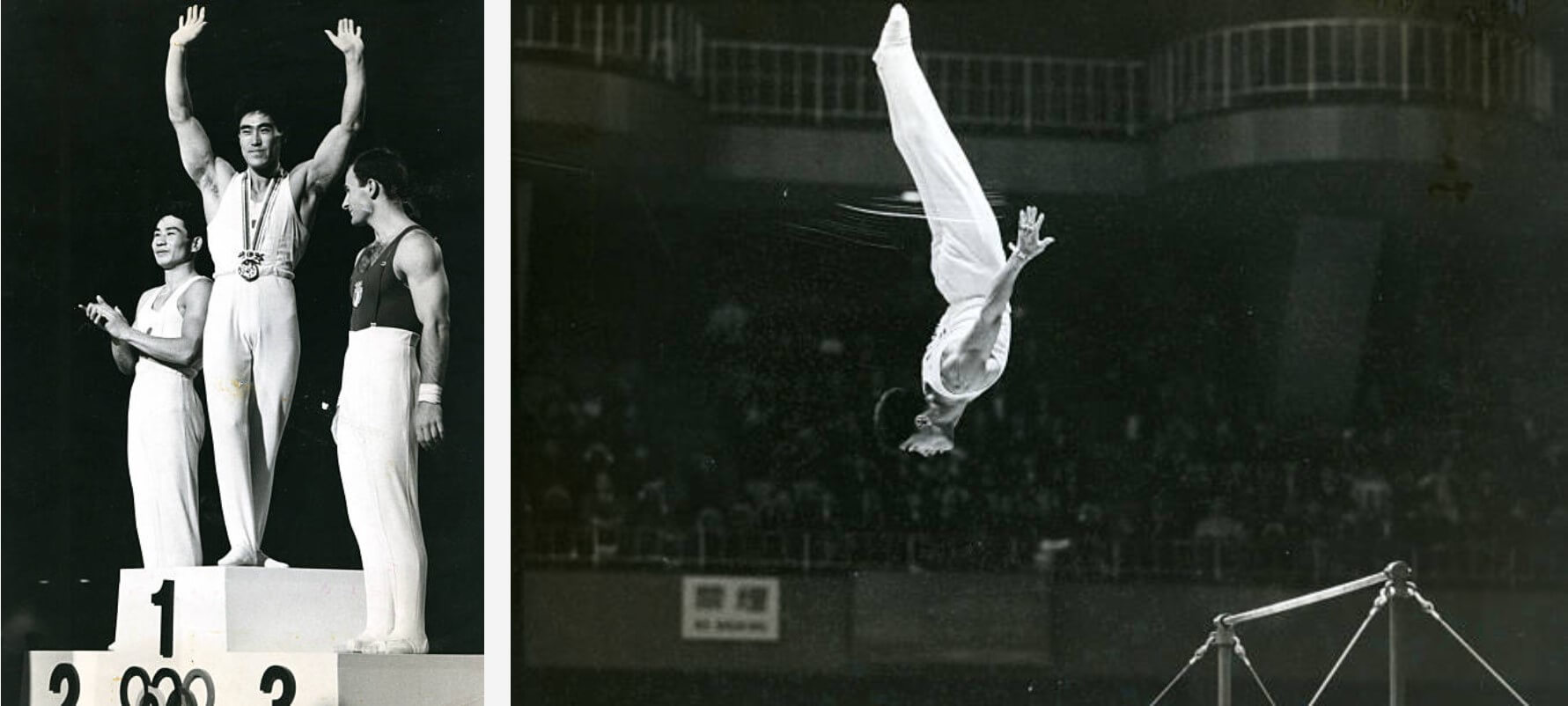
1964 Olympic Games
in Tokyo
YUKIO ENDO.
1964 Olympic Games in Tokyo
YUKIO ENDO.
1964 Olympic Games in Tokyo
YUKIO ENDO.
1972 Olympic Games
in Munich
YUKIO ENDO (COACH)
OLYMPIC CHAMPIONS: AKINORI NAKAYAMA, TERUICHI OKAMURA, EIZŌ KENMOTSU, SAWAO KATŌ, MITSUO TSUKAHARA, SHIGERU KASAMATSU.
1972 Olympic Games in Munich
YUKIO ENDO (COACH)
OLYMPIC CHAMPIONS: AKINORI NAKAYAMA, TERUICHI OKAMURA, EIZŌ KENMOTSU, SAWAO KATŌ, MITSUO TSUKAHARA, SHIGERU KASAMATSU.
1972 Olympic Games in Munich
YUKIO ENDO (COACH)
OLYMPIC CHAMPIONS: AKINORI NAKAYAMA, TERUICHI OKAMURA, EIZŌ KENMOTSU, SAWAO KATŌ, MITSUO TSUKAHARA, SHIGERU KASAMATSU.

1970-1979
JOCHEN PEITZ AND SEIJI NAGASE.
1970-1979
JOCHEN PEITZ AND SEIJI NAGASE.
1970-1979
JOCHEN PEITZ AND SEIJI NAGASE.
Friendship until today
JOCHEN PEITZ AND SEIJI NAGASE.
JOCHEN PEITZ AND MARCEL.
Friendship until today
JOCHEN PEITZ AND SEIJI NAGASE.
JOCHEN PEITZ AND MARCEL.
Friendship until today
JOCHEN PEITZ AND SEIJI NAGASE.

2021 Olympic Games
in Tokyo
MARCEL.
2021 Olympic Games in Tokyo
MARCEL.
2021 Olympic Games in Tokyo
MARCEL.
+49 (0) 162 70 83 570 | info@marcelhaupt.com | Impressum & Datenschutz | Social Creative Playbook
JOIN MY LIST.
